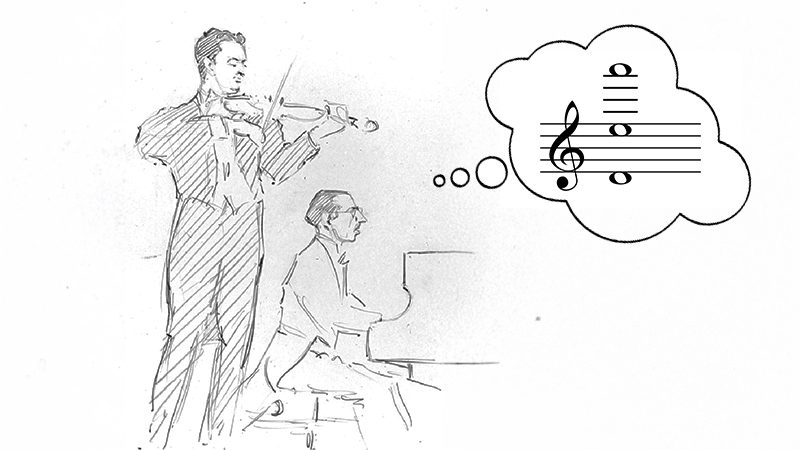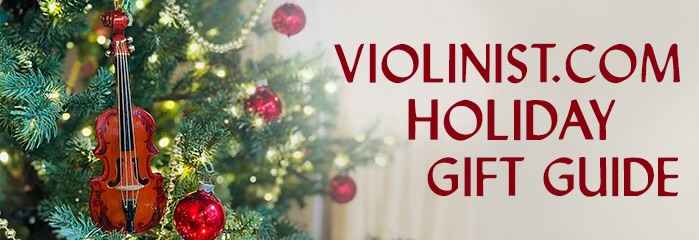Violinist William Shaub Tackles Stravinsky's 'Passport Chord'
Stravinsky wrote his Violin Concerto in D not only for violinist Samuel Dushkin, but in consultation with him. Those familiar with the piece know that it starts with a chord that spans more than two octaves - practically speaking, an open "D" topped by a rather unusual 11th double-stop. In fact, the chord begins every movement of the concerto.
But they might not know the story behind the chord. It involves a restaurant in Paris, a paper napkin, and a "no" that turned into a "yes." Violinist William Shaub, who is concertmaster of the Knoxville Symphony, explains the "passport chord":
About the concerto, Stravinsky noted that "virtuosity for its own sake has a small role in my Concerto, and the technical demands of the piece are relatively tame." Really, Igor? Tell that to my left hand!

A pencil sketch of Igor Stravinsky and Samuel Dushkin from around 1930, and Stravinsky's "passport chord."
Evidently, Stravinsky had some mistrust of virtuosos. He wrote: "In order to succeed they are obliged to lend themselves to the wishes of the public, the great majority of whom demand sensational effects from the player. This preoccupation naturally influences their taste, their choice of music, and their manner of treating the piece selected. How many admirable compositions, for instance, are set aside because they do not offer the player any opportunity of shining with facile brilliancy!"
Personally, I think Stravinsky’s concerto offers the player many opportunities to shine and I look forward to Shaub shining, as he performs as soloist with the Knoxville Symphony Orchestra later this week.
A few fun facts about Dushkin
In addition to premiering Stravinsky’s Violin Concerto, Dushkin inspired Stravinsky's Duo Concertante and Divertimento for violin and piano, both works which he wrote for Dushkin to perform on concert tours, with the composer at the keyboard.
Dushkin also gave the premiere of Ravel’s orchestral version of his Tzigane, with Pierre Monteux conducting the Concertgebouw Orchestra.
Dushkin commissioned William Schuman’s Violin Concerto, which came with a contractual agreement that Dushkin had exclusive performing rights for three years. When the concerto proved too difficult for Dushkin, the ultimate premiere by Isaac Stern was delayed for the duration of this three-year period while Dushkin (stubbornly) maintained his exclusivity rights.
...and how do you play that "Passport Chord"?
His advice was to start with the high "A": "Plant the four, and stretch back like it’s yoga class!"
* * *
Enjoying Violinist.com? Click here to sign up for our free, bi-weekly email newsletter. And if you've already signed up, please invite your friends! Thank you.
Replies
Hah!
Tom, it’s a bridge over troubled water, to be sure. A do-able chord but not a comfy one!
The Rite of Spring and the Left of String?
Tom, According to Laurie, this officially qualifies as a bad "violin Dad" joke. (And I love it!)
Buri, YES!!! Thank you!
The score clearly indicates that all three notes of the chord should be sustained. No violinist that I know of does this, but there is a way of doing that. Play the high A on the A string and the D and E on open strings. This pushes the A string low enough so that all three strings can be played simultaneously. Try it!
Michael, That is really clever!
This article has been archived and is no longer accepting comments.
Violinist.com is made possible by...
Dimitri Musafia, Master Maker of Violin and Viola Cases
International Violin Competition of Indianapolis
Violinist.com Holiday Gift Guide
Johnson String Instrument/Carriage House Violins
Subscribe
Laurie's Books
Discover the best of Violinist.com in these collections of editor Laurie Niles' exclusive interviews.

Violinist.com Interviews Volume 1, with introduction by Hilary Hahn

Violinist.com Interviews Volume 2, with introduction by Rachel Barton Pine










November 12, 2024 at 05:54 PM · Which side of the bridge is the A on?